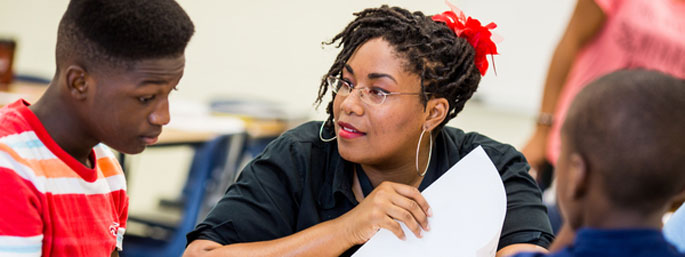Over the past 15 years, TNTP has trained more than 32,000 teachers to make a difference in some of the country’s most challenging classrooms. Every day, in communities from East New York to Oakland, CA, Teaching Fellows are changing lives and putting students on paths to a brighter future.
As new Teaching Fellows enter the classroom for the first time this fall, we asked four alumni of our training program to reflect on the back-to-school season. What are their best strategies for getting the school year off to a strong start? Here’s what we heard:
Get to know your parents—and their goals for their students—right away.
You can’t work as a team with your students’ parents unless you understand what their goals for their students are. So every year I send out a survey to my parents to get their perspectives on what they think my job is.
In the survey I introduce myself, provide my phone number and ask them questions about how to make this year a successful one for their students. Questions like:
What’s worked for your student in the past?
What has a teacher done that you felt really supported your student?
What’s the most important thing I should know about your child?
Their answers are always different, but always helpful. For some parents, it’s important that I work with their child after school. For others, that their child gets homework every night. For others, that I interact one-on-one.
Even if I can’t take all their advice, it’s helpful to understand where that parent is coming from. There’s a lot of important information about your students that only parents know, and the only way you’ll know too is if you ask.
–Chelsea Yondo, 2012 Indianapolis Teaching Fellow. Chelsea teaches high school social studies in Indianapolis.
Establish a regular contact routine with parents from the get-go.
I think too often, parents are only contacted as a last resort, when their child’s behavior or performance hasn’t met expectations. I like to establish a regular contact routine up front, rather than wait until a problem comes up to reach out.
My approach is to call or email each parent in the beginning weeks to introduce myself and let them know that I’ll be periodically updating them on how their child is doing. Parents appreciate that I’ve reached out proactively, and I think they’re more likely to partner with me down the road as a result.
I’ve found that including parents from day one pushes students to work harder, as well. By establishing that parent-teacher relationship early on, you’re helping yourself achieve more as a teacher. It’s a time commitment up front that ultimately makes your job easier.
–Charles Beavers, 2012 Chicago Teaching Fellow. Charles teaches 3rd – 5th grade intermediate special education in Chicago.
Stay connected to the big picture.
Having gone “back to school” six times, I’ve found that it’s really important to take time at the start of each year to reflect on why I do what I do. As a veteran teacher it can be easy to lose steam and go on autopilot, so I find ways to actively remind myself that while most of my content and teaching strategies are the same as last year’s, my kids aren’t. They are new students with urgent learning needs, and it’s up to me to meet those needs.
One way I stay inspired is by taking time outside of school to find out about the social and political issues that play in education, and understand my role in those issues.
I follow several Facebook pages that provide a steady stream of important education-related articles, including:
The New York Times Learning Network
Reading up on why this work is so important—for my students, for our community and for society at large—keeps me connected to the bigger picture and enables me to teach with the same energy I had when I first began teaching six years ago.
–Katie Schmelzer, 2009 Philadelphia Teaching Fellow. Katie teaches K – 8th grade music & art in Brooklyn, NY.
Pace yourself.
At the start of the year, it’s really easy to throw your entire life into your kids and your school. And while it’s wonderful to feed off of the back-to-school excitement, it’s hard to sustain that type of workload past the first marking period.
I’ve found that I have to maintain myself as a human being in order to maintain my classroom. Teachers’ work/life balance so often goes out the window. I’ve watched so many teachers who, for example, love to go running, but don’t have time for it once the school year starts, and they come to school cranky and burnt out as a result.
I recommend two strategies that have helped me personally maintain a sustainable work/life balance:
Put your personal time into your calendar. Sit down with your calendar and pencil in time to go running, or go to the gym, or whatever it is you want to do, and then stick to it. By planning in advance, you can then schedule your work time around that.
Sit down with a more experienced teacher and ask them to share their secrets. There are so many resources out there for teachers, but it can be hard to know which ones are best. Instead of wasting time by wading through all of them aimlessly, sit down with a colleague you admire and get their tricks of the trade. Chances are they’ll have a lot of advice that will not only save you time, but will also help you improve as a teacher. For example, I’ve learned to lesson plan in ways I didn’t think possible, thanks to the Microsoft Word formatting tips one of my colleagues gave me.
However you approach the beginning of school, keep one thing in mind: Your students need you the entire year—not just the first two months.
–Andrea Brinker, 2012 Nashville Teaching Fellow. Andrea teaches 5th grade math in Nashville.

